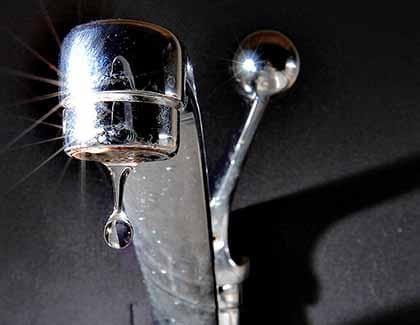By Connor Adams Sheets
The city launched a new campaign last week to educate residents about simple precautions they can take to reduce potential exposure to lead from plumbing in their homes.
The “Run Your Tap” campaign, a joint effort between the city Departments of Health and Environmental Protection, suggests two simple steps that can go a long way to reducing exposure, which is most likely in older homes.
The city emphasized during an event at the DEP’s headquarters in Corona announcing the initiative that though tap water in New York’s reservoirs and throughout its distribution system is virtually lead-free and of high quality, lead in homes’ pipes can filter into the clean water, introducing a hazard, particularly for small children.
“Some older buildings in the city have lead pipes, or pipes with lead fixtures, which can affect residences’ tap water by introducing lead into water that has been sitting in the pipes for several hours or more,” DEP Commissioner Cas Halloway said.
In order to avoid lead contamination through the faucet, the city first recommends that people let tap water run until it is cold or for at least 30 seconds until the water is noticeably colder before drinking it, using it to cook or making baby formula or any time a faucet has not been used for several hours.
Second, it recommends that residents use cold tap water for drinking, cooking and making baby formula. Hot water should not be used for cooking or drinking even if it is boiled because doing so does not reduce lead levels. Instead, cold water should be heated or boiled to necessary temperatures.
The implementation of these two ideas should cost households about $1 per month, the city said.
The use of cold water reduces the possibility that lead will be present in tap water because hot water dissolves lead more quickly, and also because a hot water heater can contribute more lead to water.
The city launched the campaign in response to a series of tests between June and September 2010, which found that the level of lead in homes’ tap water was slightly elevated. But while DOH Commissioner Thomas Farley said the levels found do not pose a grave danger, the city wants to keep lead exposure to the absolute minimum.
“The elevations seen in the city’s recent tests have been too small to pose clear health threats — lead-based paint is the primary source of exposure in New York City, and we will continue to focus on it,” Farley said. “But the best level of lead exposure is zero, especially for children and pregnant women.”
Lead poisoning may cause learning and behavior problems and delays in growth and development in children, according to the DEP.
Call 311 for more information from the DOH about the health effects of lead, causes of lead poisoning and how to have a child’s blood tested for lead poisoning. The DEP will also provide free lead testing kits to 311 callers who request them.
Reach reporter Connor Adams Sheets by e-mail at csheets@cnglocal.com or by phone at 718-260-4538.
































